By Peter Hossli (text) and Robert Huber (fotos)
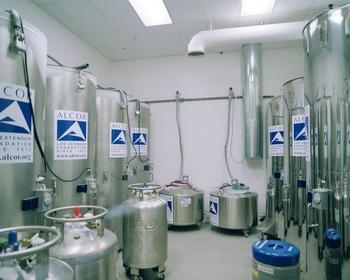
A tour of Alcor offers a strange glimpse at the futuristic predictions of physics professor Robert Ettinger, who in 1964 in his cult book The Prospect of Immortality claimed: ”Sooner or later, our friends in the future will have the ability to reanimate and heal us”.
Hixon Sr is not alone. As of July, 2006, Alcor Life Extension Foundation had 800 members, and 74 patients in cryopreservation in a clinically cold industrial building in Scottsdale, Arizona. This includes about a dozen house pets, mainly dogs and cats. Alcor members who would like to be laid to rest in frosty nitrogen are willing to dig deep in their pockets to pay for the service. Whole body suspension – from head to toe – costs $US150,000 ($200,000) and neurosuspension (just the head) costs $US80,000 ($106,000).
Not expensive at all, thinks Hixon, a former U.S. Air Force officer and now chief technician at Alcor, which is indisputably the market leader among the three American cryonics providers. ”Enormous” are the rewards, says the biochemist.
”It’s like the lottery. You don’t know if you’ll win,” says Hixon. ”To win, you have to first buy a lottery ticket.”
Cryonics comes from the Greek word ”cryos” for cold; it is an invention from the science-fiction-obsessed ’60s. Three years after Ettinger’s sci-fi book was released in 1964, a Californian, Dr James Bedford, had himself suspended. And in 1972, Fred Chamberlain and his wife, Linda, founded the Alcor Foundation.
Alcor still stores the cryo-pioneer Bedford, the first man on ice.
”At that time, it was more like theatre than real medicine,” says Hixon. They keep Bedford for nostalgic reasons.
”Maybe, he’s still living,” he says. ”Since he was the first to expose himself to the danger, he has a right to his last chance.”
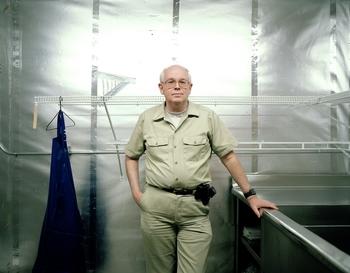
Hixon is wearing beige cotton trousers, a beige military shirt and underneath a grey T-shirt; moths have chewed three holes in the collar. He is single. He considers death a ”compulsory chore”. He hasn’t ”the slightest interest” in it.
Except for a white, wispy wreath of hair, the 60-year old man is bald. Next to his black digital watch he wears a small steel armband. It identifies him as an Alcor follower and contains strict instructions. When Hixon dies, his body should be handled lightning fast and immaculately ”in order to prevent damage to my body tissue for the future”, he says.
Once a doctor pronounces you dead, every minute counts. When the circulation stops in the brain, a chemical reaction begins to attack the cells immediately and turn them into a sludgy liquid mass. To prevent the disastrous decay, the cryo-patient is attached to a heart-lung machine.
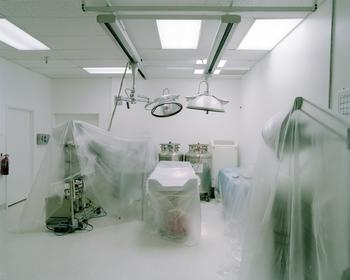
”Old, but functional” is how Hixon describes the meagre room. He’s attended almost all the suspension procedures. Using a drip, he replaces both blood and water with a glycerol based chemical solution that prevents ice formation, called Viaspan. This procedure, named vitrification (deep cooling without freezing) should prevent what cryonics critics’ emphasise the most, the pulverisation of tissue by intense cold.
”The cells are placed in a glass type matrix which takes between six and eight hours,” says Hixon. In the ”cryonically protected” cranium, he drills two button-size holes and places a piece of wire in each; microphones to hear any fractures. The patient is then placed on dry ice, wrapped in a white plastic cover to cool down slowly to -130C (one degree an hour so that the cells don’t crack). Finally, the technician wedges the body into a narrow aluminium box and stuffs him in to a steel canister filled with liquid nitrogen.
”For safety reasons, we place the head downward,” explains Hixon. If the nitrogen should unexpectedly evaporate quickly, the vacuum would be lost. The head of the gazing patient, according to cryonic teachings the most important organ, would remain intact longer like this. Each individual head ends up in an aluminium pot that resembles a spaghetti pan.
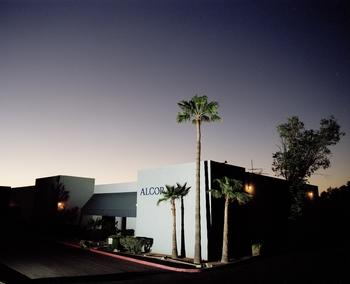
Hixon leads me into the plastic-covered operating room. Everywhere there are notes marked ”A-1235. No known contagious illness”.A-1235 is dying. He could arrive at any moment. Hixon has cleaned the operating table, filled the container with anti-freeze and double-checked the heart-lung machine. The press is banned during the suspension procedure; a decapitation would be too grisly and bad for Alcor’s image. Alcor does record everything on video though. One day, the patients will be able to admire their beginning with no ending.
Hixon considers death ”a problem that engaged me for a long time, but now I’ve got a handle on it”. Thanks to Alcor, his lifeboat. He has nothing to lose anyway.
”The people from afar will only summon us in a peaceful world,” he says. ”If the world is hostile, they will leave me in my tank.”
Why is he so certain that it will work?
”Because,” says Hixon as he flips the light switch twice in the windowless operating room (it becomes dark, then light again), ”in the middle of the night, I can make it light without the sun. Technology works . . . always.”
”God’s will? That’s a joke,” says Hixon. ”Since we climbed down from the trees, we’ve always undermined God’s will.”
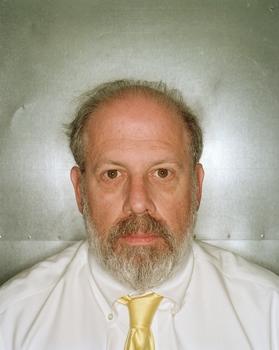
He is the first doctor at the top. The majority of members are between 39 and 62 years old, and almost all are childless.
He sits in a small office with his wrinkled yellow tie and a white shirt that covers his big belly.
Lemler describes in detail how some day new bodies can be grown again under frozen heads. And how the three main cryonic problems – healing an illness, the ageing process and the reparation of destroyed cell materials – will be remedied. Scientists are ”very close” to stopping the ageing process, he says. Recently such futuristic practices as cloning, nanomedicine and stem-cell research have shown advances.
Lemler closed his practice in Tennessee and relinquished 80 per cent of his salary, ”for the most important task in my career”.
Often he goes alone to the small storage room with the eight 3m-high round canisters. It looks like a dairy. There, Lemler spends ”many precious, intimate hours with my patients”. He became conscious then that ”I am their only voice and I have to campaign for their rights”. A ”noble cause”, says Lemler.
”We are not waking dead people up,” he says. ”That’s God’s problem. Our patients are alive.” He follows the euthanasia debate in Europe attentively. His ideal would be if the cryonic procedure were introduced directly after death.
”Organs then maintain the best protection. To suspend someone when they were alive, however, would be murder,” he says.
Besides, says Alcor technician Hixon, ”the life insurance company wouldn’t pay”.
But what happens to those who die far away from Phoenix? Occasionally, nearly dead members travel to the desert city so that, immediately after their death, they can be filled up with anti-freeze and mothballed in bitter cold nitrogen.
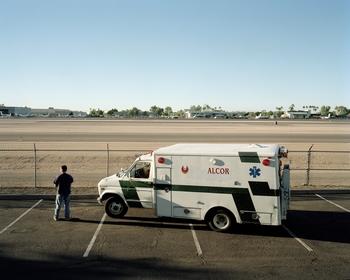
Alcor’s archivist is Mike Perry, an emaciated guy in shabby clothes. With a blunt pencil, he records daily the nitrogen-water level in the logbook. When necessary, he replenishes the icy brew. Round the clock, Perry hangs out at the Alcor building. He takes emergency calls and writes articles on refrigeration technology.
Cryonics fascinated him as a 12-year-old when he read a science-fiction story on life after death. ”I liked the idea of not being dead. Then I started to view death as a scientific problem,” says Perry, 55 and a computer scientist.
Perry himself has big plans.
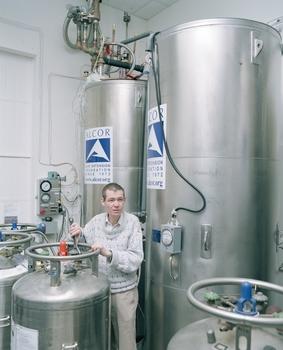
Definitely the afterworld of the frozen will want to be defrosted in due time despite foreseeable overpopulation. ”Archeologists will jump for joy,” he says.
Alcor’s best ally is time.
”It doesn’t matter if we have to wait a 100 or 1000 years to be thawed out,” says David Pizer, a Phoenix real estate broker, already 20 years an Alcor member. ”It’s similar to a deep sleep. We won’t know when we wake up how long we were out.” Ten years ago, he convinced his wife, Trudy, to opt for endless happiness in the future.
”We made the decision to always stay together,” says Trudy. The childless pair will hardly feel lonely. The animal lovers also have had two great danes and a mini bull terrier frozen.
Scientifically, cryonics stands on wobbly legs. Refrigeration scientists smile about it. For them, if you’re dead you’re dead. Thawing attempts with animals have failed. The anti-freeze solution is poisonous.
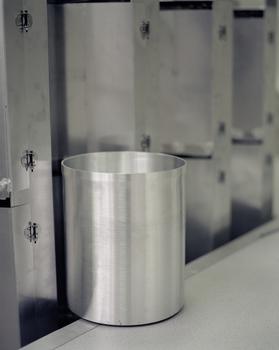
They finally had a bit of luck when sport legend Ted Williams, the Pele of baseball, died at 85. In the media, his children were fighting over whether he wanted to be frozen or not. Then the New York Times reported that Ted Williams was swimming in Scottsdale in a nitrogen bath.
Since then, Alcor chief Jerry Lemler has given more than 500 interviews ”to eliminate prejudices”. The number of requests for membership has risen dramatically. Alcor induced the enormous interest by promising to provide a number of cities in America with freezer facilities and expanding internationally.
In the future, Australians and Brits can be frozen in their homeland, which would minimise the length of time between death and suspension. Lemler hopes in addition that a law will be passed that would legitimise the non-regulated practice – in contrast to France and British Columbia in Canada which prohibit cryonics.
He is striving to minimise operational expenses. The liquid nitrogen, delivered by a tanker every two weeks, costs about $2660 a month. The yearly fees alone that the Alcor members pay cover this tenfold. The salaries of Alcor employees are deliberately low ”for the sake of science”, says Alcor CEO Lemler. About 97 per cent of the 800 members have taken out life insurance to the benefit of Alcor.
Potentially the foundation is sitting on a fortune worth $US70,000 ($93 million).
Cryonics members can now take their fortune with them in the future. Instead of bequeathing an inheritance to their descendants, they can deposit their wealth into an Alcor fund, which is supposedly a beneficial start capital for the numerous men and women who some day will come out of the cold. If they come out.
The Big Chill
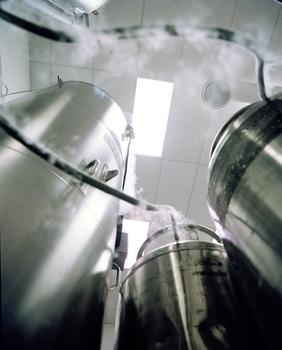
* TED WILLIAMS, the American baseball legend, is the most famous cryopreserved person. His daughter lost a bizarre legal battle to prevent her father’s head being preserved after his death in 2002. Williams’ body is held at the Alcor Suspension Facility, Scottsdale, Arizona. His head is held in a separate container.
* THE FIRST Australian to be cryonically preserved was Roy Schiavello, of Melbourne, who in 1990 died aged 30 from a brain tumor. His body is stored at the Alcor facility in Scottsdale, Arizona.
* AN ADELAIDE man in his 60s underwent preliminary perfusion at an SA funeral parlour in April, 2002, before being sent to the Cryonics Institute in Detroit. He had insisted he remain anonymous.
* AUSTRALIAN comedian ”Ugly” Dave Gray in 1999 arranged to have his body cryopreserved after death, at the Cryonics Institute, Detroit. Upfront cost: $60,000.
* WALT DISNEY was said to have had his body cryopreserved. However, this is a myth. Disney was cremated and is buried at Forest Lawn Memorial Park Cemetery, Hollywood, California.

looking for fimancial suport to be cryonically frozen
This topic totally facinates me, i wont be cremated and im terrified of being buried but i am not scared of death or dying. the thought of dying twice actually makes me think is it worth it but if it is possible and its a huge leap of faith then Yes i want to be frozen and i want to believe in the possibility ..
I strongly suggest that we can freeze Michael Jackson’s Brain and body in case we can save him in the future once we have the ability to do it.
I think it would be very meaningful cause he is not a person we can copy. He is the one. We will be surely regretful if we don’t do it.
Thank you very much and best regards.
33
I’m so sad that i found this too late,but it’s not really too late i expect.i strongly suggest that frozon Michael Jackson’s body or brain to make him alive in the future,it would be wonderful and meaningful.it also will attract more people to focus on this technology.it’s positive and great.
Everybody want Michael Jackson to back to us,please give a chance,frozen him,and save him.
I believe it works.
Yes, of all people it seems Michael Jackson would have been interested in cryonics, since he wanted to be Peter Pan and said he wouldn’t be buried because he would life forever. But, that worked against him because like a lot of us he felt he would never die and never made arrangements.
The only thing we’re all pretty much assured of is that we’re going to die someday. Plan now and buy life insurance for Alcor or the Cryonics Institute. If it doesn’t work, you’ve lost virtually nothing with a possibility (however small) of everything to gain. If you’re religious, I see even more of an argument for it. If God wants it to work, it’ll work.
If you are buried, you’ll be eaten by bacteria and your organs will turn to liquid, and if you’re cremated, your head will explode as your blood boils inside it, and that’s how they know the cremation is done.
Funny how news articles never mention those details about burial or cremation, but reporters such as this one try to say things about Alcor. Your body with Alcor will remain closest to what it is now, rather than the alternatives of burial or cremation.